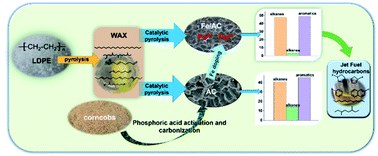Jet fuel-range hydrocarbon production from catalytic pyrolysis of low-density polyethylene by metal-loaded activated carbon†
Abstract
Catalytic pyrolysis of plastic wastes into valuable jet fuel is of great potential to tackle the energy and environmental concerns induced by the continuously increasing usage of petroleum-based polymers. Herein, we studied the catalytic pyrolysis of low-density polyethylene (LDPE) with Fe, Co, Ni and other metal-loaded activated carbon (AC) catalysts for efficient production of value-added aviation fuels. It was found that the introduction of iron carbide and iron oxides into AC by facile impregnation is essential to improve the catalytic activity. After adjusting the catalytic temperature and the loading ratio of Fe content, the proportion of olefins in the liquid product decreased significantly, with a minimum content of 1.89 area%, while the maximum content of hydrocarbons in the jet fuel range reached 96.17 area%. Fe active sites form more low-chain olefins by promoting β-scission reactions, and olefins aromatize on acidic sites to form aromatic hydrocarbons. In addition, Fe active sites can adsorb carbonaceous intermediates and activate C–H bonds and catalyze hydrogen transfer reactions between cycloalkanes and olefins, upgrading them to alkanes and aromatics in the jet fuel range. Our work may provide a facile and environment-friendly strategy for fabricating Fe/AC bifunctional catalysts for efficient catalytic conversion of LDPE into valuable fuel products.



 Please wait while we load your content...
Please wait while we load your content...